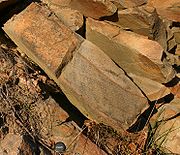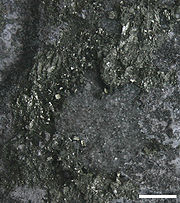
Bald Eagle Formation
Encyclopedia
The Ordovician
Bald Eagle Formation is a mapped bedrock unit in central Pennsylvania
, USA. It is a ridge-forming
unit in the Appalachian Mountains
.
 The Bald Eagle is defined as a gray to olive-gray and grayish-red, fine to coarse-grained crossbedded sandstone
The Bald Eagle is defined as a gray to olive-gray and grayish-red, fine to coarse-grained crossbedded sandstone
or greywacke
. A conglomeratic
member, called the Lost Run Member, exists in some locations.
of the Bald Eagle has always been intrepreted as mostly terrestrial or shallow marine deposits resulting in a molasse
sequence produced by the Taconic orogeny
.
s. However, at the base of the formation is the Orthorynchula biostratigraphic
marker bed, which contains abundant Orthorynchula brachiopods.
period, being deposited between 488.3 to 443.7 (±10) million years ago. It rests conformably atop the Reedsville Formation
and conformably below the Juniata Formation
.
 The Bald Eagle is a good source of road material, riprap
The Bald Eagle is a good source of road material, riprap
and building stone. However, iron pyrite inclusions may lead to acidic rainwater runoff.
Ordovician
The Ordovician is a geologic period and system, the second of six of the Paleozoic Era, and covers the time between 488.3±1.7 to 443.7±1.5 million years ago . It follows the Cambrian Period and is followed by the Silurian Period...
Bald Eagle Formation is a mapped bedrock unit in central Pennsylvania
Pennsylvania
The Commonwealth of Pennsylvania is a U.S. state that is located in the Northeastern and Mid-Atlantic regions of the United States. The state borders Delaware and Maryland to the south, West Virginia to the southwest, Ohio to the west, New York and Ontario, Canada, to the north, and New Jersey to...
, USA. It is a ridge-forming
Cliff-former
The term cliff-former is a geologic term indicating that a unit of bedrock is more resistant to erosion than overlying or underlying units and consequently outcrops have high slope angles. It is more or less equivalent to ridge-former, and may be contrasted with slope-former. In humid...
unit in the Appalachian Mountains
Appalachian Mountains
The Appalachian Mountains #Whether the stressed vowel is or ,#Whether the "ch" is pronounced as a fricative or an affricate , and#Whether the final vowel is the monophthong or the diphthong .), often called the Appalachians, are a system of mountains in eastern North America. The Appalachians...
.
Description

Sandstone
Sandstone is a sedimentary rock composed mainly of sand-sized minerals or rock grains.Most sandstone is composed of quartz and/or feldspar because these are the most common minerals in the Earth's crust. Like sand, sandstone may be any colour, but the most common colours are tan, brown, yellow,...
or greywacke
Greywacke
Greywacke or Graywacke is a variety of sandstone generally characterized by its hardness, dark color, and poorly sorted angular grains of quartz, feldspar, and small rock fragments or lithic fragments set in a compact, clay-fine matrix. It is a texturally immature sedimentary rock generally found...
. A conglomeratic
Conglomerate (geology)
A conglomerate is a rock consisting of individual clasts within a finer-grained matrix that have become cemented together. Conglomerates are sedimentary rocks consisting of rounded fragments and are thus differentiated from breccias, which consist of angular clasts...
member, called the Lost Run Member, exists in some locations.
Depositional environment
The depositional environmentSedimentary depositional environment
In geology, sedimentary depositional environment describes the combination of physical, chemical and biological processes associated with the deposition of a particular type of sediment and, therefore, the rock types that will be formed after lithification, if the sediment is preserved in the rock...
of the Bald Eagle has always been intrepreted as mostly terrestrial or shallow marine deposits resulting in a molasse
Molasse
The term "molasse" refers to the sandstones, shales and conglomerates formed as terrestrial or shallow marine deposits in front of rising mountain chains. The molasse is deposited in a foreland basin, especially on top of flysch, for example that left from the rising Alps, or erosion in the Himalaya...
sequence produced by the Taconic orogeny
Taconic orogeny
The Taconic orogeny was a mountain building period that ended 440 million years ago and affected most of modern-day New England. A great mountain chain formed from eastern Canada down through what is now the Piedmont of the East coast of the United States...
.
Fossils
Very few fossils exist in the Bald Eagle Formation, and most of them are trace fossilTrace fossil
Trace fossils, also called ichnofossils , are geological records of biological activity. Trace fossils may be impressions made on the substrate by an organism: for example, burrows, borings , urolites , footprints and feeding marks, and root cavities...
s. However, at the base of the formation is the Orthorynchula biostratigraphic
Biostratigraphy
Biostratigraphy is the branch of stratigraphy which focuses on correlating and assigning relative ages of rock strata by using the fossil assemblages contained within them. Usually the aim is correlation, demonstrating that a particular horizon in one geological section represents the same period...
marker bed, which contains abundant Orthorynchula brachiopods.
Age
Relative age dating of the Bald Eagle places it in the Upper OrdovicianOrdovician
The Ordovician is a geologic period and system, the second of six of the Paleozoic Era, and covers the time between 488.3±1.7 to 443.7±1.5 million years ago . It follows the Cambrian Period and is followed by the Silurian Period...
period, being deposited between 488.3 to 443.7 (±10) million years ago. It rests conformably atop the Reedsville Formation
Reedsville Formation
The Ordovician Reedsville Formation is a mapped surficial bedrock unit in Pennsylvania, Maryland, Virginia, West Virginia, and Tennessee, that extends into the subsurface of Ohio. This rock is a slope-former adjacent to the prominent ridge-forming Bald Eagle sandstone unit in the Appalachian...
and conformably below the Juniata Formation
Juniata Formation
The Ordovician Juniata Formation is a mapped bedrock unit in Pennsylvania and Maryland. It is a relative slope-former occurring between the two prominent ridge-forming sandstone units: the Tuscarora Formation and the Bald Eagle Formation in the Appalachian Mountains.-Description:The Juniata is...
.
Economic Uses

Riprap
Riprap — also known as rip rap, rubble, shot rock or rock armour or "Rip-rap" — is rock or other material used to armor shorelines, streambeds, bridge abutments, pilings and other shoreline structures against scour, water or ice erosion.It is made from a variety of rock types, commonly granite or...
and building stone. However, iron pyrite inclusions may lead to acidic rainwater runoff.
See also
- Geology of PennsylvaniaGeology of PennsylvaniaThe Geology of Pennsylvania consists of six distinct physiographic provinces, three of which are subdivided into different sections. Each province has its own economic advantages and geologic hazards and play an important role in shaping everyday life in the state...

